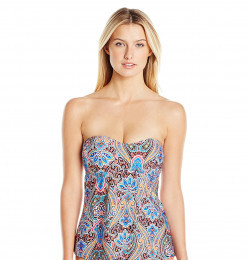

Jantzen
Miami, FL 33172
USA
About
founded by
John A. Zehntbauer & Carl C. Jantzen
belongs to
Perry Ellis International, Inc.
about
Jantzen is a brand of swimwear that was established in 1916 and first appeared in the city of Portland, Oregon, United States.
John A. Zehntbauer, Carl C. Jantzen and C. R. Zehntbauer founded Portland Knitting Company,
the predecessor of Jantzen Inc, in January 1910 in Portland, Oregon. The company was a small
retail store and knitting operation in downtown Portland. The firm manufactured heavy sweaters,
woolen hosiery and other knit goods, and acted as a retailer of apparel products.
The Zehntbauers and Jantzen were great outdoorsmen and members of the Portland Rowing Club.
In 1913 a fellow club member asked if the company could knit a woolen suit suitable for use while
rowing in the rainy winter weather. The rib-stitched suit proved to be a popular product and its
development marked an important turning point for the young company.
While expansion of production continued during and immediately following World War I, swimwear
sales were still a modest part of the firm�s business. Recognizing the value of a brand name for the
new product, Portland Knitting Company was renamed Jantzen Knitting Mills in June 1918.
As swimwear sales increased markedly in the postwar expansion, Jantzen was a leader in
promotion of its new product. In 1920 billboards showing the company�s suits were featured in
San Francisco and Los Angeles. National advertising began in 1921 with ads illustrating Jantzen
suits placed in Vogue and the old Life magazine.
The cover of the 1920 catalog featured an illustration of a diving woman, clad in a red suit
complete with stockings and cap. Some admirers had cut the �Red Diving Girl� from the catalog
and pasted it on the windshields of their automobiles. This fad spread beyond the West Coast
when Jantzen officials pasted them on windows of a train enroute to a Shriners� convention in
Washington, D.C. The image was adopted as the logo of the company and became recognizable
worldwide. In 1932 it was reported to be the seventh most known trademark in the world.
As the 1930s began, difficult economic times turned into what became known as the �Great
Depression.� This dismal state continued for most of the decade. All business struggled to stay
afloat and the upturn did not come about until 1939. Production of war material for England and
her allies triggered an economic recovery in the United States.
In moves to diversify from a one product seasonal company, Jantzen resumed the manufacture of
sweaters in 1938. This was followed in 1939 by production of �foundations� as girdles and corsets
were called in that day. And in 1940, Sun Clothes, which we would now call active sportswear,
augmented the company�s line of products.
After the United States entered World War II in December 1941, production for the civilian market
wound down slowly to minimum levels.
In the 1950s additional production and shipping facilities were established in Seneca, South
Carolina to speed distribution of company goods to eastern retailers. Plants in other parts of the
country and Canada produced swimwear and sportswear under the Jantzen label. Reflecting a
broader range of products, the firm name was changed in January 1954 to Jantzen Inc.
In the aftermath of World War II, Jantzen relied more on licensees for production and distribution of
swimwear in international markets. This proved to be more successful than trying to maintain
company owned facilities in Europe, South America and Asia.
During the 1960s and 70s, the company continued the manufacture and sales of sweaters,
swimwear, sportswear and intimate apparel. The latter division was closed in the late 70s. The
girdle business had virtually disappeared and bra sales tended to be concentrated with fewer and
fewer large producers.
In February 1980, control of Jantzen was purchased by Blue Bell, the Greensboro, North Carolina
manufacturer of Wrangler jeans and other apparel products. Turmoil in the apparel industry was
rampant in the 1980s and Blue Bell was acquired in 1986 by VF Corporation. Jantzen continued to
operate as a subsidiary of VF, one of the largest apparel producers in the country.
A significant change occurred in 1995 when management opted to exit from production of
menswear and concentrate on women�s apparel. Swimwear had been the key product when
Jantzen first emerged as a nationally recognized company. It was felt that expanding its position
as the number one brand name in swims was the paramount objective.
The sales marketplace had undergone numerous changes in the last two decades. Major
department stores, once the dominant retailers for apparel, have experienced the rise of national
discount retailers and fancy outlet stores. Catalog vendors carved out another niche in the retail
apparel scene. E-commerce has become a popular retailing method and Jantzen has its website
for showcasing its products with on-line purchasing made easy for the customer.
In 2002 the Jantzen brand was purchased by Perry Ellis International, Inc. This included the Nike
and Tommy Hilfiger swimwear licenses. Perry Ellis International markets products in over forty
different categories world-wide. Perry Ellis is in the process of expanding both men�s and women�s
product offerings.
Official Social Media
Latest Jantzen Advertisements


